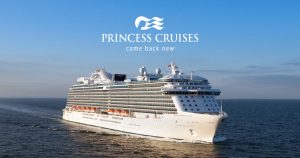FLORIDA
 Princess Cruise Lines will pay the largest-ever criminal penalty for polluting the seas by dumping oil contaminated waste into the ocean. Princess Cruise plead guilty to seven felony charges stemming from its deliberate pollution of the seas and intentional acts to cover it up.
Princess Cruise Lines will pay the largest-ever criminal penalty for polluting the seas by dumping oil contaminated waste into the ocean. Princess Cruise plead guilty to seven felony charges stemming from its deliberate pollution of the seas and intentional acts to cover it up.
Princess will pay a record $40 million penalty related to illegal dumping of oil contaminated waste from the Caribbean Princess cruise ship.
Princess, headquartered in Santa Clarita, California, is a subsidiary of Carnival Corporation, which owns and operates multiple cruise lines and collectively comprises the world’s largest cruise company. Carnival is headquartered in Miami.
“The pollution in this case was the result of more than just bad actors on one ship,” said Assistant Attorney General John C. Cruden. “It reflects very poorly on Princess’s culture and management. This is a company that knew better and should have done better. Hopefully the outcome of this case has the potential not just to chart a new course for this company, but for other companies as well.”
As part of the plea agreement with Princess, cruise ships from eight Carnival cruise line companies — Carnival Cruise Line, Holland America Line N.V., Seabourn Cruise Line Ltd. and AIDA Cruises — will be under a court supervised Environmental Compliance Program for five years. The Compliance Program will require independent audits by an outside entity and a court appointed monitor, according to officials.
PRINCESS VISITED SEVERAL U.S. PORTS
 The charges to which Princess will plead guilty concern the Caribbean Princess cruise ship which visited various U.S. ports in Florida, Maine, Massachusetts, New Jersey, New York, Puerto Rico, Rhode Island, South Carolina, Texas, U.S. Virgin Islands and Virginia.
The charges to which Princess will plead guilty concern the Caribbean Princess cruise ship which visited various U.S. ports in Florida, Maine, Massachusetts, New Jersey, New York, Puerto Rico, Rhode Island, South Carolina, Texas, U.S. Virgin Islands and Virginia.
If approved by the court, $10 million of the $40 million criminal penalty will be devoted to community service projects to benefit the maritime environment; $3 million of the community service payments will go to environmental projects in South Florida; $1 million will be earmarked for projects to benefit the marine environment in United Kingdom waters, according to officials.
BRITISH MARITIME TRIGGERED INVESTIGATION
The U.S. investigation was initiated after information was provided to the U.S. Coast Guard by the British Maritime and Coastguard Agency indicating that a newly hired engineer on the Caribbean Princess reported that a so-called “magic pipe” had been used on Aug. 23, 2013, to illegally discharge oily waste off the coast of England.
The whistleblowing engineer quit his position when the ship reached Southampton, England. The chief engineer and senior first engineer ordered a cover-up, including removal of the magic pipe and directing subordinates to lie, officials said.
The MCA shared evidence with the U.S. Coast Guard, including before and after photos of the bypass used to make the discharge and showing its disappearance.
The U.S. Coast Guard conducted an examination of the Caribbean Princess upon its arrival in New York City, New York, on Sept. 14, 2013, during which certain crew members continued to lie in accordance with orders they had received from Princess employees.
COURT EVIDENCE SPELL OUT VIOLATIONS
 According to papers filed in court, the Caribbean Princess had been making illegal discharges through bypass equipment since 2005, one year after the ship began operations.
According to papers filed in court, the Caribbean Princess had been making illegal discharges through bypass equipment since 2005, one year after the ship began operations.
The discharge on Aug. 26, 2013, involved approximately 4,227 gallons, 23 miles off the coast of England within the country’s Exclusive Economic Zone.
At the same time as the discharge, engineers simultaneously ran clean seawater through the ship’s overboard equipment in order to create a false digital record for a legitimate discharge, according to court papers.
Caribbean Princess used multiple methods over the course of time to pollute the seas. Prior to the installation of the bypass pipe used to make the discharge off the coast of England, a different unauthorized valve was used.
When the Department of Justice investigative team conducted a consensual boarding of the ship in Houston, Texas, on March 8, 2014, they found the valve that crew members had described. When it was removed by Princess at the department’s request, it was found to contain black oil, officials said.
OTHER ILLEGAL PRACTICES UNCOVERED
 In addition to the use of a magic pipe to circumvent the oily water separator and oil content monitor required pollution prevention equipment, the U.S. investigation uncovered two other illegal practices which were found to have taken place on the Caribbean Princess as well as four other Princess ships – Star Princess, Grand Princess, Coral Princess and Golden Princess.
In addition to the use of a magic pipe to circumvent the oily water separator and oil content monitor required pollution prevention equipment, the U.S. investigation uncovered two other illegal practices which were found to have taken place on the Caribbean Princess as well as four other Princess ships – Star Princess, Grand Princess, Coral Princess and Golden Princess.
One practice was to open a salt water valve when bilge waste was being processed by the oily water separator and oil content monitor. The purpose was to prevent the oil content monitor from otherwise alarming and stopping the overboard discharge.
This was done routinely on the Caribbean Princess in 2012 and 2013. The second practice involved discharges of oily bilge water originating from the overflow of gray-water tanks into the machinery space bilges.
This waste was pumped back into the gray-water system rather than being processed as oily bilge waste. Neither of these practices were truthfully recorded in the oil record book as required.
All of the bypassing took place through the gray-water system which was discharged when the ship was more than four nautical miles from land. As a result, discharges within U.S. waters were likely.
“The conduct being addressed today is particularly troubling because the Carnival family of companies has a documented history of environmental violations, including in the Southern District of Florida,” said U.S. Attorney Wilfredo Ferrer. “Our hope is that all companies abide by regulations that are in place to protect our natural resources and prevent environmental harm. Today’s case should send a powerful message to other companies that the U.S. government will continue to enforce a zero tolerance policy for deliberate ocean dumping that endangers the countless animals, marine life and humans who rely on clean water to survive.”
This shows just how well the U.K. and U.S. can work together on these kind of cases,” said Jeremy Smart, head of enforcement at the Maritime & Coastguard Agency of the United Kingdom. “It also sends a clear message to the industry that this kind of pollution practice will not be tolerated anywhere in the world. It also shows that we will always take any information we are given by those who report such practices to us very seriously and will act upon it.”
In addition to the criminal information, a plea agreement and joint factual statement were filed in court Thursday in Miami.
Photographs of some of the evidence provided by the whistleblower and obtained by the government were also filed in federal court. In the factual statement, Princess also admitted to the following:
- Illegal discharges took place on the Caribbean Princess dating back to 2005, one year after the vessel started operations, as part of a conspiracy to violate the Act to Prevent Pollution from Ships and to obstruct justice.
- Different bypass methods were used over the course of time, including a “magic pipe” used to transfer oily waste overboard.
- After learning that an engineer had blown the whistle, senior ship engineers dismantled the bypass pipe and instructed crew members to lie.
Prior to the MCA boarding, the chief engineer and senior first engineer ordered crew members to lie. - Following the MCA’s inquiry, the chief engineer held a sham meeting in the engine control room to pretend to look into the allegations while holding up a sign stating: “LA is listening.” The engineers present understood that anything said might be heard by those at the company’s headquarters in Los Angeles, California, because the engine control room contained a recording device intended to monitor conversations in the event of an incident.
- When using the magic pipe, engineers processed sea water through the oily water separator in order to create a digital record to account for the missing waste.
Shore-side management failed to provide and exercise sufficient supervision and management controls to prevent or detect criminal violations by Caribbean Princess crew members.
CRIME FINANCIALLY MOTIVATED

A perceived motive for the crimes was financial – the chief engineer that ordered the dumping off the coast of England told subordinate engineers that it cost too much to properly offload the waste in port and that the shore-side superintendent who he reported to would not want to pay the expense.
Princess engineers on the Caribbean Princess indicated that the chief engineer responsible for the discharge on Aug. 26, 2013, was known as “broccino corto” (a person with short arms), an Italian expression for a cheap person whose arms are too short to reach his wallet. Some expressed the same opinion of the shore-side superintendent.
Graywater tanks overflowed into the bilges on a routine basis and were pumped back into the graywater system and then improperly discharged overboard when they were required to be treated as oil contaminated bilge waste.
The overflows took place when internal floats in the graywater collection tanks got stuck due to large amounts of fat, grease and food particles from the galley that drained into the graywater system. Graywater tanks overflowed at least once a month and, at times, as frequently as once per week. Princess had no written procedures or training for how internal gray water spills were supposed to be cleaned up and the problem remained uncorrected for many years.
Princess discovered “stub pipes” along the entire length of the ship for the apparent purpose of pumping graywater overflows into the bilges back into the graywater system and subsequently overboard.
According to papers filed in court, Princess has undertaken remedial measures in response to the government’s investigation, including upgrading the oily water separators and oil content monitors on every ship in its fleet and instituting many new policies.
*** Prosecution was made possible through the combined efforts of the U.S. Coast Guard Investigative Service, the U.S. Coast Guard 7th District Legal Office, U.S. Coast Guard’s Office of Maritime and International Law and U.S. Coast Guard Office of Investigations and Analysis. In announcing the case, Assistant Attorney General Cruden and U.S. Attorney Ferrer expressed their appreciation to the U.K.’s MCA for their cooperation and assistance. The case was prosecuted by Richard A. Udell, Senior Litigation Counsel with the Environmental Crimes Section of the Department of Justice and Thomas Watts-FitzGerald, Deputy Chief, Economic & Environmental Crimes Section for the Southern District of Florida.

